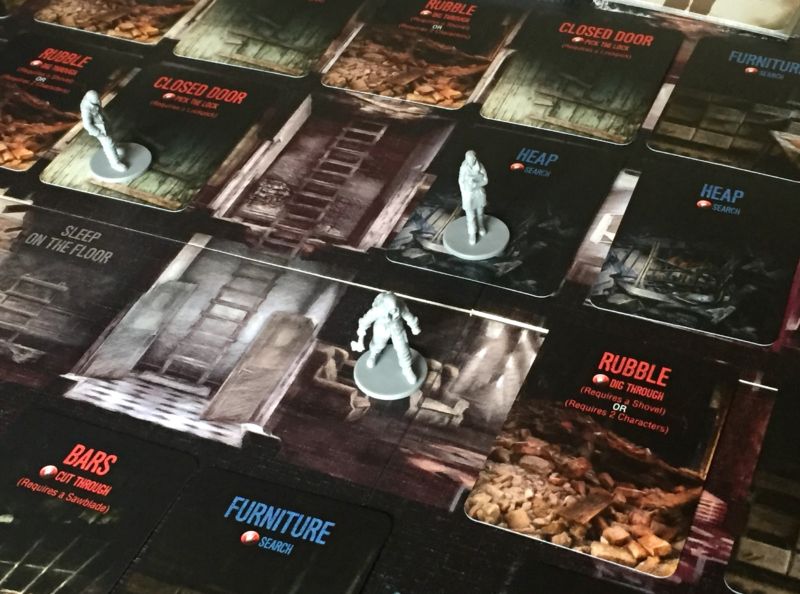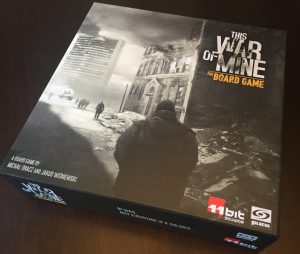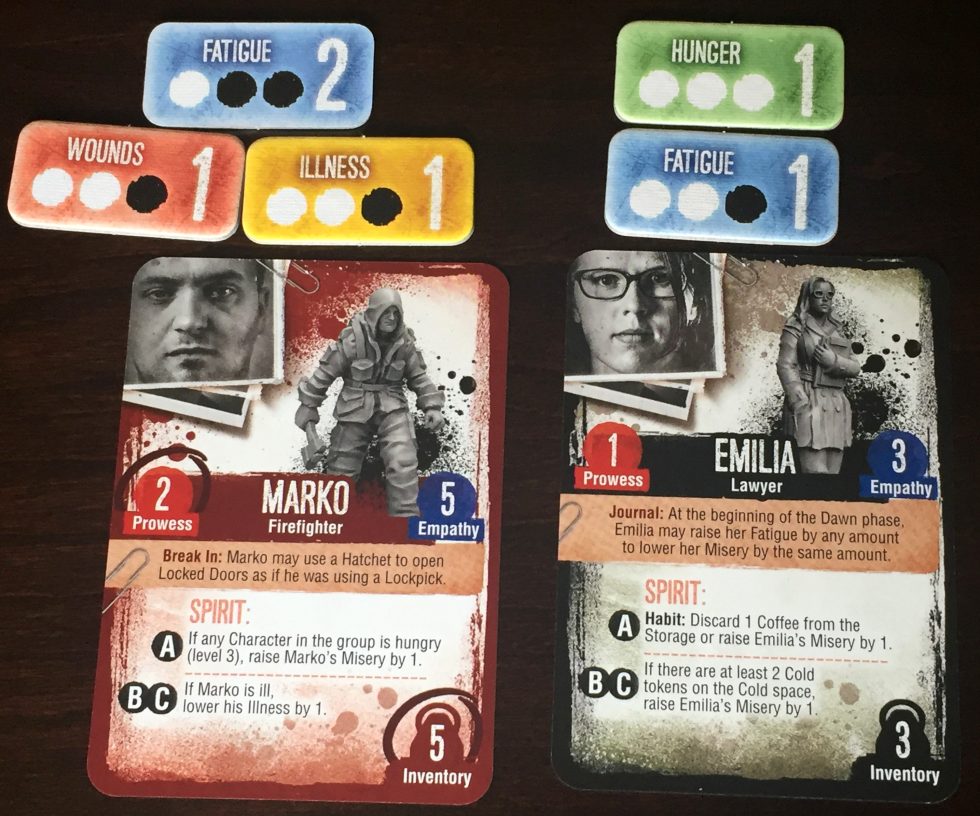
This War of Mine is a giant punch to the gut. Inspired by the war in Sarajevo, the concept here tilts the notion of a "war game" on its head, presenting war not as explosions and bullets but as hunger and pneumonia. The game sets out to create a gritty experience, one of discomfort and anguish, and the good news (or the bad news, depending on your perspective) is that the challenging moral dilemmas are as compelling in the cardboard version as they were in the critically acclaimed 2014 video game.
Long is the day

This War of Mine is a cooperative experience of shared narrative. Players coordinate actions among a group of war-weary survivors holed up in a dilapidated multi-story ruin. Your people are starving, bruised, and emotionally broken, but you still need wood and pieces of machinery. During the day phase, you'll move miniatures about the house and assign them to tasks. Perhaps you'll expend a great deal of energy to dig up the bricks and mortar blocking the passage upstairs. Maybe you'll search through the broken furniture in what was once a living room.
You can take the scraps you find and build anew. You can craft a bed to recover from fatigue or build a dead-fall trap hoping beyond hope to catch some food. You can build everything from an herb garden to a plain old chair. But you'll never have enough time, energy, or supplies to accomplish everything you need. Actions are limited, and they diminish as health plummets.
As the daylight fades, you have an opportunity to venture out amid the sporadic violence. Without light, the snipers and jackals patrolling the streets disappear. That's not to say everything is safe; the danger is just hidden from view, lurking in the darkness.
You must split your group into two. One section will head to a nearby location card and scavenge for supplies, while the other will remain at "home" to hold the door or perhaps gain some sleep. Anyone who doesn't rest accumulates fatigue, which is tracked on quaint little tokens. These tokens begin to pile up as you measure hunger, fatigue, illness, wounds, and misery. Guarding the door is paramount to keeping it all together, since raids occur at night, as everyone from hobos to well-armed bandits try to push their way inside.
Hopefully your scavenging attempt was successful and you've brought back some potable water, a few bits of raw food—maybe even a broken firearm you could barter with. Scrounging these items is accomplished by building a small deck of exploration cards that you burn through to search the location. This gives a clever sense of space as you run into stairwells or come across locked doors, which eat up time.
Each area you explore is different, but for the most part you’re flipping through the exploration cards hoping to find precious goods and avoid hostile residents. Combat can break out, leaving you even worse off, but more likely, you’ll gather a few useful components to shorten your never-ending shopping list.
If you're not quite satisfied, there's no need to fret; this whole cycle will repeat tomorrow.

Dark is the night
This War of Mine is a profound experience. It's not "fun" in a traditional sense, but it is engaging and tense. It's an ordeal that seeks to educate and impart empathy; the fact that it succeeds is commendable.
A significant aspect to its accomplishment is how it bucks gaming norms. There is no standard rulebook. Instead, the game offers a modest journal that walks you through each of the phases, apportioning slices of instruction in small bits.
Accompanying the journal is the book of scripts. This thick, soft-cover manual is an index of narrative snippets blended with mechanical resolutions. You don't work through this tome in an orderly fashion; you pick it up and refer to a specific numbered section when the game dictates.
Such directions come from cards flipped while searching buildings, events triggered at the start of the day, and even from visitors arriving at your doorstep. You're never quite sure when you'll head to the book of scripts.
-
The game books.
-
Running into some rubble.
-
A closeup of the game's minis.
By removing the comfort of an organized ruleset, the game puts you in the dark. It can be maddening for those wanting control, but this is intentional. The lack of authority, in combination with a reliance on very random and admittedly arbitrary outcomes, is a lesson in letting go. This unsettling goal of reducing player autonomy leaves you feeling helpless and confused at times—which is the point. It's one of the game's most effective tricks.
The immersion of This War of Mine is its primary achievement. You soon begin to make choices in the game based upon your own moral foundation. You'll pass on stealing rotten fruit from a broken family, and it will cause your people to die. But you’ll feel better about yourself the next day. Maybe.
The game also has a magnificent knack for producing completely personal stories despite a consistent, and at times repetitive, structure. The magic comes from the book of scripts and its sheer quantity of entries. Your first half-dozen plays will likely feature little to no repeat outcomes, and every nugget of narrative is juicy. It's easy to get lost in your own private hell and not realize the hours ticking by outside.
That immersion does lapse at times. While the game design has its brilliant strokes, it also has its fair share of banality. A huge portion of the game is bookkeeping—sliding counters around the board, shuffling decks of cards, and amassing tokens. Occasionally it feels like outright busy work.
This is emphasized from the get-go, with setup taking quite a bit of time. You need to seed your two-dimensional house with a number of cards, and the many decks that litter the outside edge of the board will need to be prepared in specific fashion as well.
Compounding the complexity is the fact that the game can last five (!) or more hours if you get extraordinarily lucky and survive to the end. It does offer a built-in way to save your progress via note-taking, but the whole ordeal can be arduous and persnickety over the long haul. You really need to be committed for the whole thing to work. If you buy into the immersion and theme, these issues are overshadowed by the ingenious moments and impossible choices.
This is a heavy and obtuse game that loves to throw you into the water while only occasionally letting you up for air. You never quite win at This War of Mine. If you somehow scrape by and make it to the end, you'll merely survive. It’s a depressing vision of existence—but one that deserves to be experienced.
reader comments
9